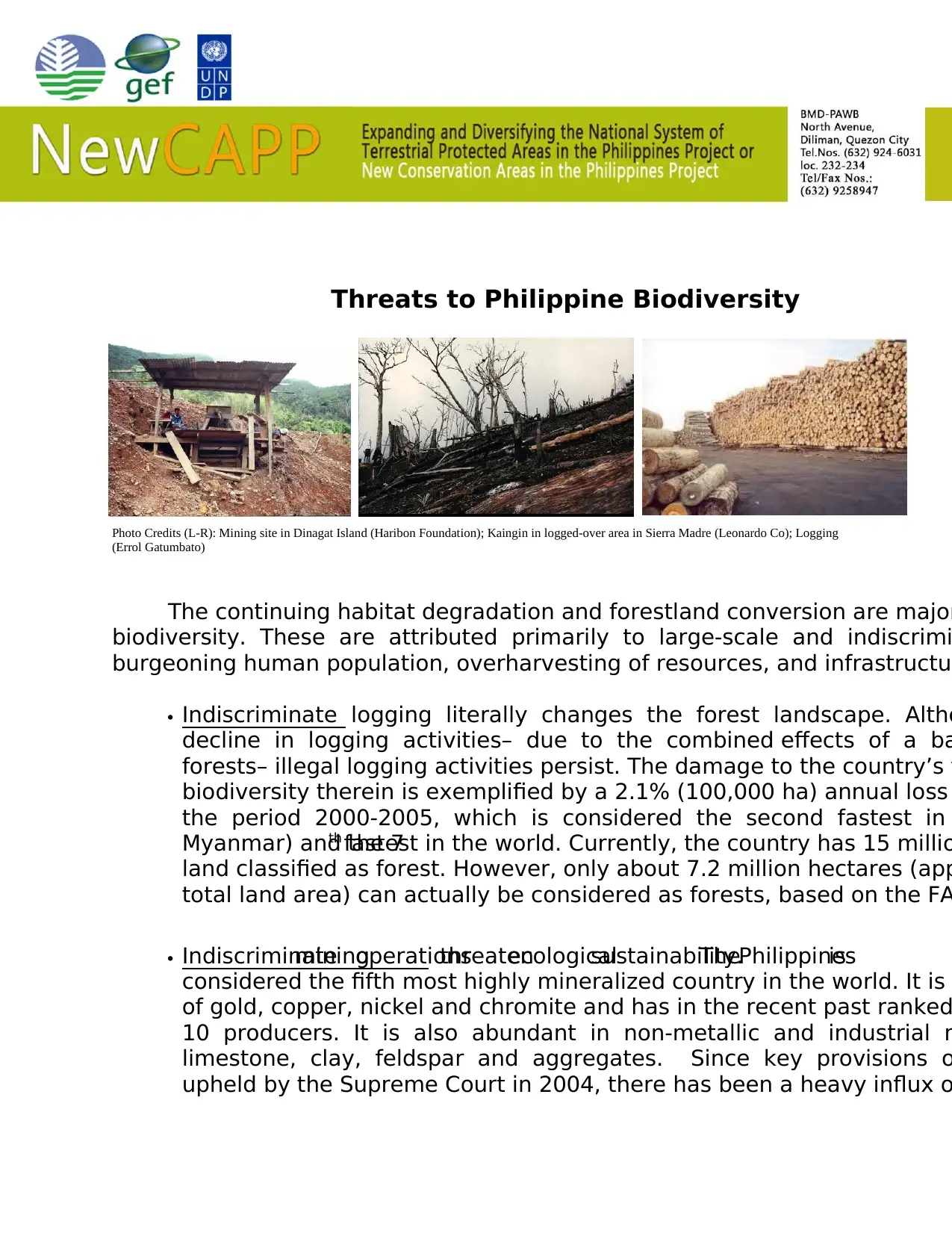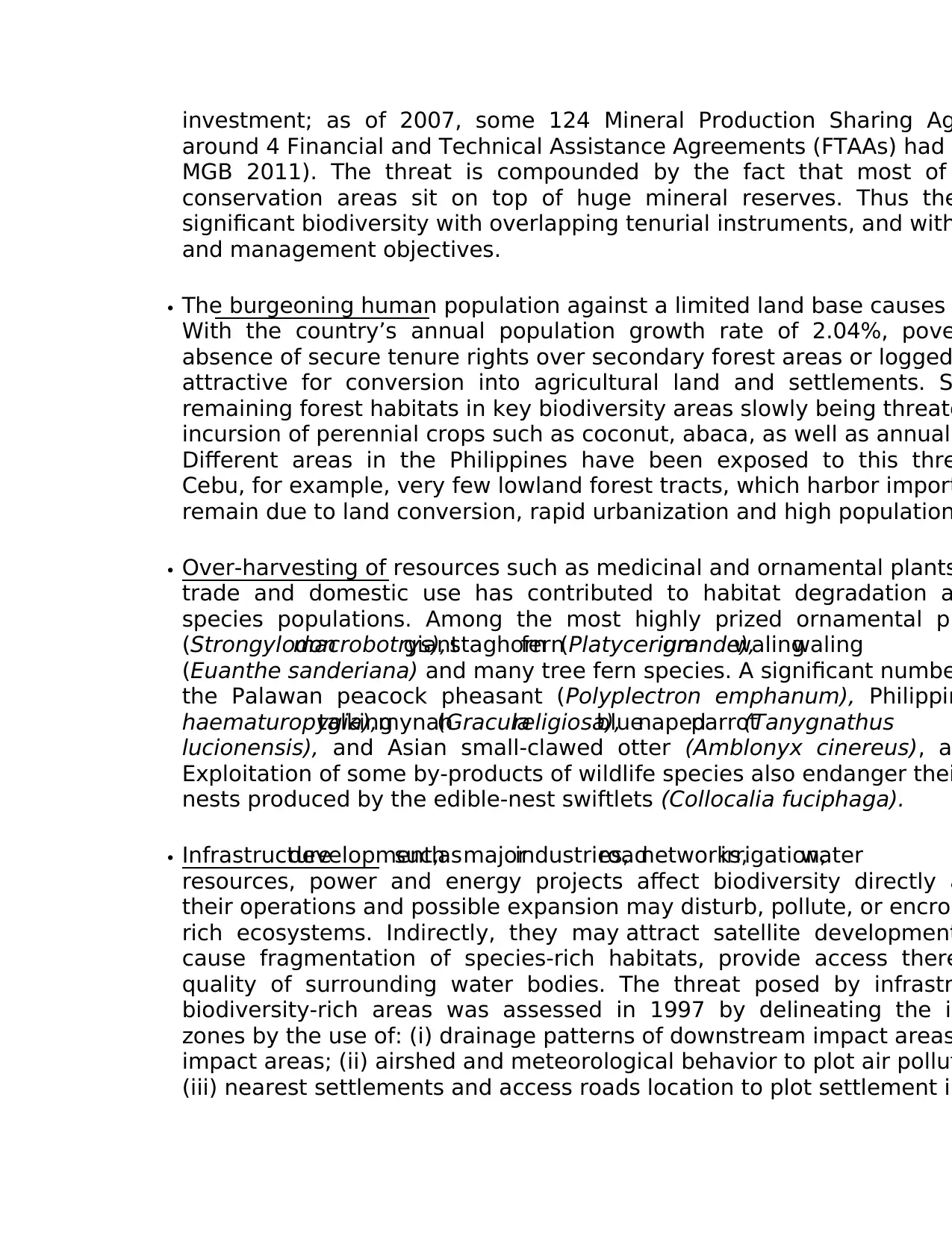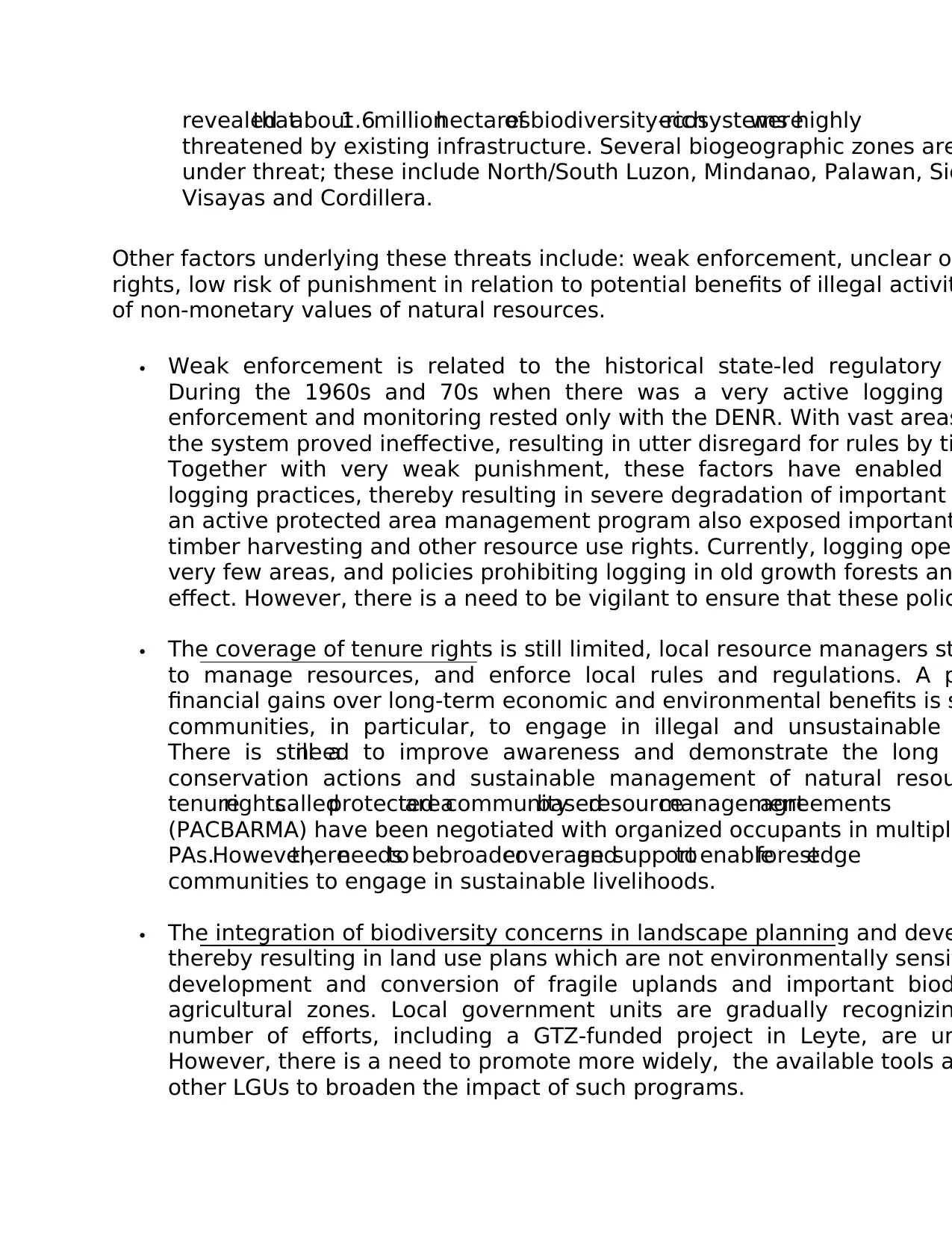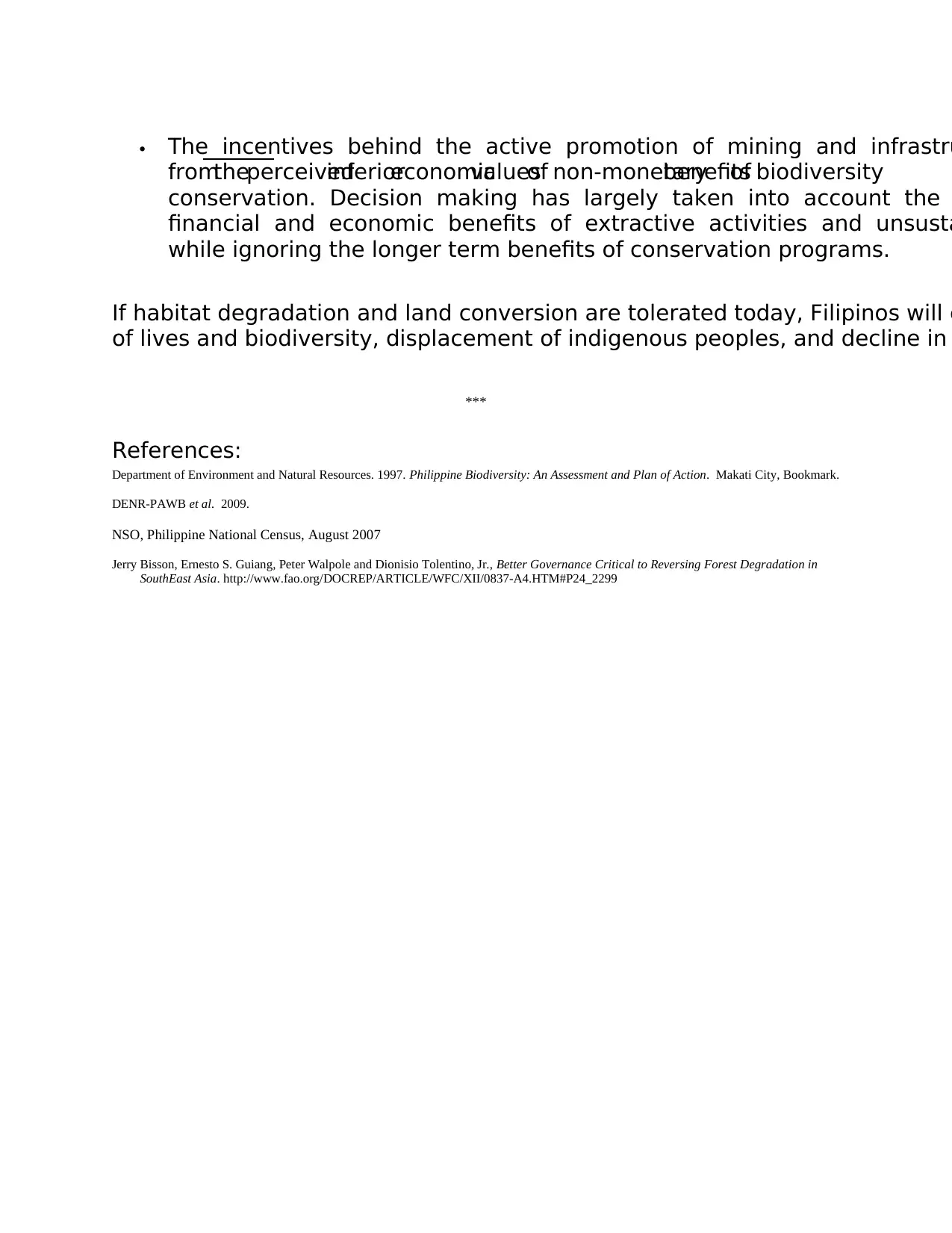Major Threats and Impacts on Philippine Biodiversity: A Report
VerifiedAdded on 2021/11/19
|4
|1452
|212
Report
AI Summary
This report provides a comprehensive overview of the significant threats to Philippine biodiversity. It identifies habitat degradation and forestland conversion as major issues, primarily attributed to indiscriminate logging and mining practices. The report highlights the impact of the burgeoning human population, leading to forestland conversion for agriculture and settlements. Over-harvesting of resources, including medicinal plants and wildlife, further exacerbates the problem. Infrastructure development is also recognized as a threat, directly and indirectly affecting biodiversity-rich ecosystems. The report discusses underlying factors such as weak enforcement of environmental regulations, unclear resource ownership, and the under-valuation of non-monetary benefits of biodiversity conservation. It emphasizes the need for stronger enforcement, improved tenure rights, integration of biodiversity concerns in landscape planning, and a shift in decision-making to prioritize long-term environmental benefits to ensure the preservation of Philippine biodiversity.

Threats to Philippine Biodiversity
Photo Credits (L-R): Mining site in Dinagat Island (Haribon Foundation); Kaingin in logged-over area in Sierra Madre (Leonardo Co); Logging
(Errol Gatumbato)
The continuing habitat degradation and forestland conversion are major
biodiversity. These are attributed primarily to large-scale and indiscrimi
burgeoning human population, overharvesting of resources, and infrastructur
Indiscriminate logging literally changes the forest landscape. Altho
decline in logging activities– due to the combined effects of a ba
forests– illegal logging activities persist. The damage to the country’s f
biodiversity therein is exemplified by a 2.1% (100,000 ha) annual loss
the period 2000-2005, which is considered the second fastest in
Myanmar) and the 7th fastest in the world. Currently, the country has 15 millio
land classified as forest. However, only about 7.2 million hectares (app
total land area) can actually be considered as forests, based on the FA
Indiscriminateminingoperationsthreatenecologicalsustainability.ThePhilippinesis
considered the fifth most highly mineralized country in the world. It is
of gold, copper, nickel and chromite and has in the recent past ranked
10 producers. It is also abundant in non-metallic and industrial m
limestone, clay, feldspar and aggregates. Since key provisions o
upheld by the Supreme Court in 2004, there has been a heavy influx o
Photo Credits (L-R): Mining site in Dinagat Island (Haribon Foundation); Kaingin in logged-over area in Sierra Madre (Leonardo Co); Logging
(Errol Gatumbato)
The continuing habitat degradation and forestland conversion are major
biodiversity. These are attributed primarily to large-scale and indiscrimi
burgeoning human population, overharvesting of resources, and infrastructur
Indiscriminate logging literally changes the forest landscape. Altho
decline in logging activities– due to the combined effects of a ba
forests– illegal logging activities persist. The damage to the country’s f
biodiversity therein is exemplified by a 2.1% (100,000 ha) annual loss
the period 2000-2005, which is considered the second fastest in
Myanmar) and the 7th fastest in the world. Currently, the country has 15 millio
land classified as forest. However, only about 7.2 million hectares (app
total land area) can actually be considered as forests, based on the FA
Indiscriminateminingoperationsthreatenecologicalsustainability.ThePhilippinesis
considered the fifth most highly mineralized country in the world. It is
of gold, copper, nickel and chromite and has in the recent past ranked
10 producers. It is also abundant in non-metallic and industrial m
limestone, clay, feldspar and aggregates. Since key provisions o
upheld by the Supreme Court in 2004, there has been a heavy influx o
Paraphrase This Document
Need a fresh take? Get an instant paraphrase of this document with our AI Paraphraser

investment; as of 2007, some 124 Mineral Production Sharing Ag
around 4 Financial and Technical Assistance Agreements (FTAAs) had b
MGB 2011). The threat is compounded by the fact that most of
conservation areas sit on top of huge mineral reserves. Thus the
significant biodiversity with overlapping tenurial instruments, and with
and management objectives.
The burgeoning human population against a limited land base causes
With the country’s annual population growth rate of 2.04%, pove
absence of secure tenure rights over secondary forest areas or logged
attractive for conversion into agricultural land and settlements. S
remaining forest habitats in key biodiversity areas slowly being threate
incursion of perennial crops such as coconut, abaca, as well as annual
Different areas in the Philippines have been exposed to this thre
Cebu, for example, very few lowland forest tracts, which harbor import
remain due to land conversion, rapid urbanization and high population
Over-harvesting of resources such as medicinal and ornamental plants
trade and domestic use has contributed to habitat degradation a
species populations. Among the most highly prized ornamental pl
(Strongylodonmacrobotrys),giantstaghornfern(Platyceriumgrande),walingwaling
(Euanthe sanderiana) and many tree fern species. A significant numbe
the Palawan peacock pheasant (Polyplectron emphanum), Philippin
haematuropygia),talkingmynah(Graculareligiosa),bluenapedparrot(Tanygnathus
lucionensis), and Asian small-clawed otter (Amblonyx cinereus), a
Exploitation of some by-products of wildlife species also endanger thei
nests produced by the edible-nest swiftlets (Collocalia fuciphaga).
Infrastructuredevelopment,suchas majorindustries,roadnetworks,irrigation,water
resources, power and energy projects affect biodiversity directly a
their operations and possible expansion may disturb, pollute, or encroa
rich ecosystems. Indirectly, they may attract satellite development
cause fragmentation of species-rich habitats, provide access there
quality of surrounding water bodies. The threat posed by infrastr
biodiversity-rich areas was assessed in 1997 by delineating the in
zones by the use of: (i) drainage patterns of downstream impact areas
impact areas; (ii) airshed and meteorological behavior to plot air pollut
(iii) nearest settlements and access roads location to plot settlement im
around 4 Financial and Technical Assistance Agreements (FTAAs) had b
MGB 2011). The threat is compounded by the fact that most of
conservation areas sit on top of huge mineral reserves. Thus the
significant biodiversity with overlapping tenurial instruments, and with
and management objectives.
The burgeoning human population against a limited land base causes
With the country’s annual population growth rate of 2.04%, pove
absence of secure tenure rights over secondary forest areas or logged
attractive for conversion into agricultural land and settlements. S
remaining forest habitats in key biodiversity areas slowly being threate
incursion of perennial crops such as coconut, abaca, as well as annual
Different areas in the Philippines have been exposed to this thre
Cebu, for example, very few lowland forest tracts, which harbor import
remain due to land conversion, rapid urbanization and high population
Over-harvesting of resources such as medicinal and ornamental plants
trade and domestic use has contributed to habitat degradation a
species populations. Among the most highly prized ornamental pl
(Strongylodonmacrobotrys),giantstaghornfern(Platyceriumgrande),walingwaling
(Euanthe sanderiana) and many tree fern species. A significant numbe
the Palawan peacock pheasant (Polyplectron emphanum), Philippin
haematuropygia),talkingmynah(Graculareligiosa),bluenapedparrot(Tanygnathus
lucionensis), and Asian small-clawed otter (Amblonyx cinereus), a
Exploitation of some by-products of wildlife species also endanger thei
nests produced by the edible-nest swiftlets (Collocalia fuciphaga).
Infrastructuredevelopment,suchas majorindustries,roadnetworks,irrigation,water
resources, power and energy projects affect biodiversity directly a
their operations and possible expansion may disturb, pollute, or encroa
rich ecosystems. Indirectly, they may attract satellite development
cause fragmentation of species-rich habitats, provide access there
quality of surrounding water bodies. The threat posed by infrastr
biodiversity-rich areas was assessed in 1997 by delineating the in
zones by the use of: (i) drainage patterns of downstream impact areas
impact areas; (ii) airshed and meteorological behavior to plot air pollut
(iii) nearest settlements and access roads location to plot settlement im

revealedthatabout1.6millionhectaresof biodiversity-richecosystemswerehighly
threatened by existing infrastructure. Several biogeographic zones are
under threat; these include North/South Luzon, Mindanao, Palawan, Sie
Visayas and Cordillera.
Other factors underlying these threats include: weak enforcement, unclear ow
rights, low risk of punishment in relation to potential benefits of illegal activit
of non-monetary values of natural resources.
Weak enforcement is related to the historical state-led regulatory
During the 1960s and 70s when there was a very active logging
enforcement and monitoring rested only with the DENR. With vast areas
the system proved ineffective, resulting in utter disregard for rules by ti
Together with very weak punishment, these factors have enabled
logging practices, thereby resulting in severe degradation of important
an active protected area management program also exposed important
timber harvesting and other resource use rights. Currently, logging oper
very few areas, and policies prohibiting logging in old growth forests an
effect. However, there is a need to be vigilant to ensure that these polic
The coverage of tenure rights is still limited, local resource managers st
to manage resources, and enforce local rules and regulations. A p
financial gains over long-term economic and environmental benefits is s
communities, in particular, to engage in illegal and unsustainable
There is still aneed to improve awareness and demonstrate the long
conservation actions and sustainable management of natural resou
tenurerightscalledprotectedareacommunitybasedresourcemanagementagreements
(PACBARMA) have been negotiated with organized occupants in multiple
PAs.However,thereneedsto bebroadercoverageandsupportto enableforestedge
communities to engage in sustainable livelihoods.
The integration of biodiversity concerns in landscape planning and deve
thereby resulting in land use plans which are not environmentally sensit
development and conversion of fragile uplands and important biod
agricultural zones. Local government units are gradually recognizin
number of efforts, including a GTZ-funded project in Leyte, are un
However, there is a need to promote more widely, the available tools a
other LGUs to broaden the impact of such programs.
threatened by existing infrastructure. Several biogeographic zones are
under threat; these include North/South Luzon, Mindanao, Palawan, Sie
Visayas and Cordillera.
Other factors underlying these threats include: weak enforcement, unclear ow
rights, low risk of punishment in relation to potential benefits of illegal activit
of non-monetary values of natural resources.
Weak enforcement is related to the historical state-led regulatory
During the 1960s and 70s when there was a very active logging
enforcement and monitoring rested only with the DENR. With vast areas
the system proved ineffective, resulting in utter disregard for rules by ti
Together with very weak punishment, these factors have enabled
logging practices, thereby resulting in severe degradation of important
an active protected area management program also exposed important
timber harvesting and other resource use rights. Currently, logging oper
very few areas, and policies prohibiting logging in old growth forests an
effect. However, there is a need to be vigilant to ensure that these polic
The coverage of tenure rights is still limited, local resource managers st
to manage resources, and enforce local rules and regulations. A p
financial gains over long-term economic and environmental benefits is s
communities, in particular, to engage in illegal and unsustainable
There is still aneed to improve awareness and demonstrate the long
conservation actions and sustainable management of natural resou
tenurerightscalledprotectedareacommunitybasedresourcemanagementagreements
(PACBARMA) have been negotiated with organized occupants in multiple
PAs.However,thereneedsto bebroadercoverageandsupportto enableforestedge
communities to engage in sustainable livelihoods.
The integration of biodiversity concerns in landscape planning and deve
thereby resulting in land use plans which are not environmentally sensit
development and conversion of fragile uplands and important biod
agricultural zones. Local government units are gradually recognizin
number of efforts, including a GTZ-funded project in Leyte, are un
However, there is a need to promote more widely, the available tools a
other LGUs to broaden the impact of such programs.
⊘ This is a preview!⊘
Do you want full access?
Subscribe today to unlock all pages.

Trusted by 1+ million students worldwide

The incentives behind the active promotion of mining and infrastru
fromtheperceivedinferioreconomicvaluesof non-monetarybenefitsof biodiversity
conservation. Decision making has largely taken into account the
financial and economic benefits of extractive activities and unsusta
while ignoring the longer term benefits of conservation programs.
If habitat degradation and land conversion are tolerated today, Filipinos will e
of lives and biodiversity, displacement of indigenous peoples, and decline in
***
References:
Department of Environment and Natural Resources. 1997. Philippine Biodiversity: An Assessment and Plan of Action. Makati City, Bookmark.
DENR-PAWB et al. 2009.
NSO, Philippine National Census, August 2007
Jerry Bisson, Ernesto S. Guiang, Peter Walpole and Dionisio Tolentino, Jr., Better Governance Critical to Reversing Forest Degradation in
SouthEast Asia. http://www.fao.org/DOCREP/ARTICLE/WFC/XII/0837-A4.HTM#P24_2299
fromtheperceivedinferioreconomicvaluesof non-monetarybenefitsof biodiversity
conservation. Decision making has largely taken into account the
financial and economic benefits of extractive activities and unsusta
while ignoring the longer term benefits of conservation programs.
If habitat degradation and land conversion are tolerated today, Filipinos will e
of lives and biodiversity, displacement of indigenous peoples, and decline in
***
References:
Department of Environment and Natural Resources. 1997. Philippine Biodiversity: An Assessment and Plan of Action. Makati City, Bookmark.
DENR-PAWB et al. 2009.
NSO, Philippine National Census, August 2007
Jerry Bisson, Ernesto S. Guiang, Peter Walpole and Dionisio Tolentino, Jr., Better Governance Critical to Reversing Forest Degradation in
SouthEast Asia. http://www.fao.org/DOCREP/ARTICLE/WFC/XII/0837-A4.HTM#P24_2299
1 out of 4
Your All-in-One AI-Powered Toolkit for Academic Success.
+13062052269
info@desklib.com
Available 24*7 on WhatsApp / Email
![[object Object]](/_next/static/media/star-bottom.7253800d.svg)
Unlock your academic potential
Copyright © 2020–2025 A2Z Services. All Rights Reserved. Developed and managed by ZUCOL.